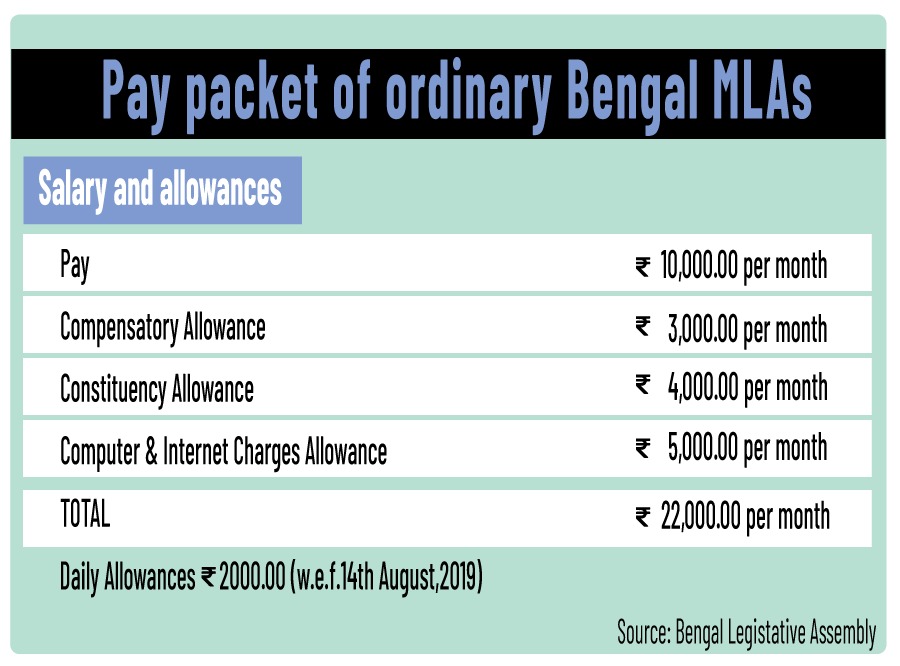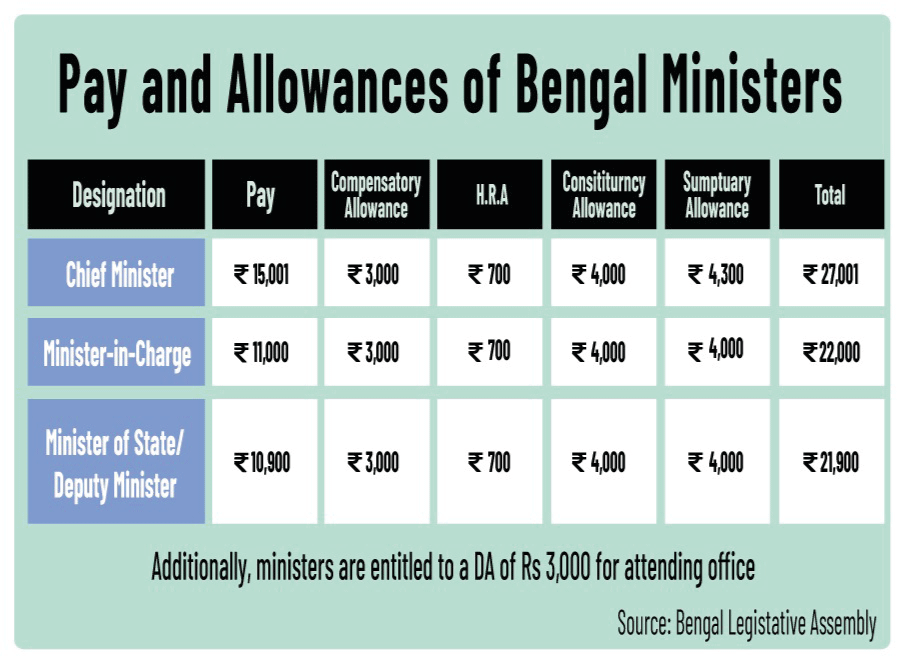Bengal parliamentary affairs minister Shovandeb Chattopadhyay fails to remember the last time his salary as a member of the state Legislative Assembly was hiked. As a minister-in-charge of two departments – agriculture and parliamentary affairs – Chattopadhyay, an MLA for 32 years, draws a monthly pay of Rs 22,000 besides perks, half of which (Rs 11,000) is taxable. Ironically, Chattopadhyay finds himself among the highest pay brackets of the House with only chief minister Mamata Banerjee drawing a consolidated higher pay of Rs 27,001 per month, only Rs 5000 more than the senior-most minister in her cabinet.
For ordinary MLAs, not holding offices, the taxable pay is currently fixed at Rs 10,000 a month and another Rs 12,000 under various non taxable allowance heads, according to the state Assembly’s compendium of member facilities last amended in September 2019. While ministers receive an additional Daily/Sitting Allowance of Rs 3000 for the average 45 days the Assembly remains in session each year and for attending standing committee meetings, the corresponding figure for ordinary legislators is Rs 2000.

Chattopadhyay says it's high time that Bengal legislators did something to erase the dubious distinction of remaining among the three lowest salary-getting states of the country, the other two being Kerala and Tripura. Compare Bengal’s figures to the emolument fixed for MLAs in neighbouring Jharkhand, a state which tops the list of highest salary getting MLAs in India, at Rs 2.9 lakhs per month and it seems Chattopadhyay has a point.
While most states in India have restricted the taxable component in MLA pay packets to Rs 55,000 or less in accordance with the respective local laws, almost all of them have provisions for additional allowance benefits under multiple heads like constituency allowance, secretarial allowance, medical allowance and so on taking the consolidated pay packet for legislators to sometimes as high as five times the basic figure. While eight states in India offer salaries upwards of Rs 2 lakh a month, five states in the country have monthly salaries lower than Rs 1 lakh. Delhi, which hiked MLA salaries by 67 percent last year, continues to remain in the latter bracket.

It’s under considerations like these that the Bengal parliamentary affairs minister introduced The Bengal Legislative Assembly (Members’ Emoluments) Amendment Bill, 2023 in the House which proposes an across-the-board hike in monthly pay by Rs 40,000 which would purportedly elevate the lawmakers’ salaries to the ‘more respectable’ position of 12th lowest in the country from the current third lowest. The Bill, which is being fiercely opposed by the opposition BJP, was supposed to be tabled for discussion in a special one-day session of the Assembly on October 16 but had to be put off for want of Governor CV Ananda Bose’s mandatory consent. With Bose now having released the Bill, it is now likely to be tabled on or after December 4 when the House assembles next for the winter session.
It’s worth reiterating that this is the first time that Mamata Banerjee has proposed a hike in salaries of her colleagues in Assembly and cabinet ever since her ascent to power in the state 12 years ago.
It’s also pertinent to mention on the other hand that additional perks of Bengal ministers include a government vehicle with a driver and fuel capped at 15 litres a day. While ordinary MLAs have no entitlement to government cars, they share with ministers travel allowances by road (Rs 5 per kilometer for the first 100 kilometers daily and Rs 3 per kilometer thereafter), rail (half of AC 2 tier fare) and air (full reimbursement of fare for self and one-fourth for attendant).

Former MLAs in Bengal are currently entitled to pensions of Rs 8,000 per month for a single term or a part thereof in the Assembly with an additional monthly Rs 500 for every additional year of membership, capped at Rs 12,000 a month. Spouses of deceased pensioners are entitled to 50 percent of last drawn pension or Rs 3,000 per month, whichever is higher. The sum, Assembly sources claimed, was also among the lowest in the country.
“BJP MLAs are not interested in salary hikes,” said Suvendu Adhikari, Leader of Opposition, earlier this week when he grudgingly landed up at the Assembly at the government’s call for a one-day special session in the midst of Puja festivities but all geared up to oppose the Bill for the eventuality of it getting tabled. “The government should instead concentrate on clearing pending DA of state government employees. The focus should be on filling up vacant positions in various state departments. The government allocates an annual Rs 60 lakhs for MLA Local Area Development fund which is a pittance given the spread of constituencies and population each MLA has to cater to. The MLA LAD figure for the Jharkhand government is Rs 8-9 crores a year. The state must first think of enhancing the LAD corpus before thinking of hiking our pay,” Adhikari lashed out.
“Why is Adhikari silent about the pay packets of MLAs in the BJP-ruled states of this country which are considerably higher?” Chattopadhyay asked in response. “The BJP advocates one-nation-one-policy for every political issue they raise. Why doesn’t the Centre consider implementation of a uniform pay structure for MLAs across the country?” the veteran leader emphasized.











